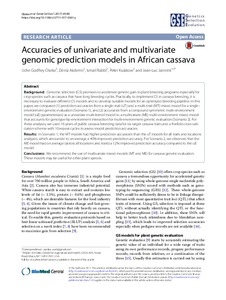| dc.contributor.author | Okeke, U.G. |
| dc.contributor.author | Akdemir, D. |
| dc.contributor.author | Rabbi, Ismail Y |
| dc.contributor.author | Kulakow, P.A. |
| dc.contributor.author | Jannink, Jean-Luc |
| dc.date.accessioned | 2019-12-04T11:11:29Z |
| dc.date.available | 2019-12-04T11:11:29Z |
| dc.date.issued | 2017 |
| dc.identifier.citation | Okeke, U.G., Akdemir, D., Rabbi, I., Kulakow, P. & Jannink, J.L. (2017). Accuracies of univariate and multivariate genomic prediction models in African Cassava. Genetics Selection Evolution, 1-10. |
| dc.identifier.issn | 0999-193X |
| dc.identifier.uri | https://hdl.handle.net/20.500.12478/2438 |
| dc.description | Open Access Journal; Published online:15 March 2017 |
| dc.description.abstract | Background: Genomic selection (GS) promises to accelerate genetic gain in plant breeding programs especially for crop species such as cassava that have long breeding cycles. Practically, to implement GS in cassava breeding, it is necessary to evaluate different GS models and to develop suitable models for an optimized breeding pipeline. In this paper, we compared (1) prediction accuracies from a single-trait (uT) and a multi-trait (MT) mixed model for a singleenvironment genetic evaluation (Scenario 1), and (2) accuracies from a compound symmetric multi-environment model (uE) parameterized as a univariate multi-kernel model to a multivariate (ME) multi-environment mixed model that accounts for genotype-by-environment interaction for multi-environment genetic evaluation (Scenario 2). For these analyses, we used 16 years of public cassava breeding data for six target cassava traits and a fivefold cross-validation scheme with 10-repeat cycles to assess model prediction accuracies.
Results: In Scenario 1, the MT models had higher prediction accuracies than the uT models for all traits and locations analyzed, which amounted to on average a 40% improved prediction accuracy. For Scenario 2, we observed that the ME model had on average (across all locations and traits) a 12% improved prediction accuracy compared to the uE model.
Conclusions: We recommend the use of multivariate mixed models (MT and ME) for cassava genetic evaluation. These models may be useful for other plant species. |
| dc.description.sponsorship | Bill & Melinda Gates Foundation |
| dc.description.sponsorship | Department for International Development, United Kingdom |
| dc.format.extent | 1-10 |
| dc.language.iso | en |
| dc.subject | Genomics |
| dc.subject | Plant Breeding |
| dc.subject | Cassava |
| dc.subject | Genotypes |
| dc.subject | Plant Genetic Resources |
| dc.title | Accuracies of univariate and multivariate genomic prediction models in African cassava |
| dc.type | Journal Article |
| dc.description.version | Peer Review |
| cg.contributor.crp | Roots, Tubers and Bananas |
| cg.contributor.affiliation | Cornell University |
| cg.contributor.affiliation | International Institute of Tropical Agriculture |
| cg.coverage.region | Africa |
| cg.coverage.region | West Africa |
| cg.coverage.country | Nigeria |
| cg.researchtheme | BIOTECH & PLANT BREEDING |
| cg.isijournal | ISI Journal |
| cg.authorship.types | CGIAR and advanced research institute |
| cg.iitasubject | Cassava |
| cg.iitasubject | Genetic Improvement |
| cg.iitasubject | Plant Breeding |
| cg.iitasubject | Plant Genetic Resources |
| cg.journal | Genetics Selection Evolution |
| cg.howpublished | Formally Published |
| cg.accessibilitystatus | Open Access |
| local.dspaceid | 93016 |
| cg.targetaudience | Scientists |
| cg.identifier.doi | http://dx.doi.org/10.1186/s12711-017-0361-y |

